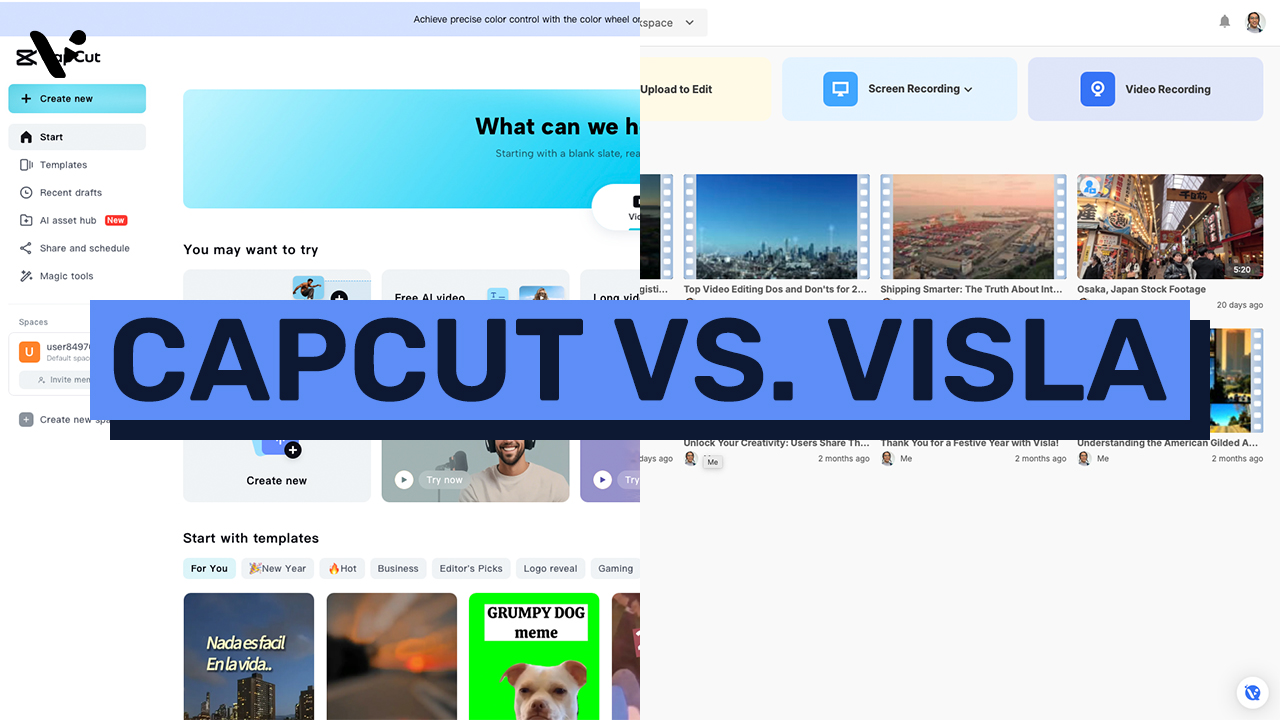Creating videos is more important than ever. Whether you’re marketing a brand, training employees, or just making fun content, you need the right tools. Two major players in the space are Visla and CapCut. Both are powerful, but they cater to very different types of users. You’ll learn all about Visla vs. CapCut and which one is best for you.
Visla: built for businesses and teams

While CapCut shines for social media, Visla is designed with businesses in mind. It’s built for efficiency, allowing teams to collaborate on high-quality video content without the learning curve. Whether you’re creating marketing videos, training content, or company updates, Visla helps you do it with ease.
One of Visla’s biggest strengths is how simple it is to get started. Unlike CapCut, which bombards you with endless effects and options, Visla gives you clear starting points. You can begin with Idea to Video, Text to Video, Webpage to Video, or use existing footage or audio to generate a polished video. You can also screen record or video record directly within Visla. This streamlined approach makes it perfect for teams that need to produce content quickly and efficiently.
Another standout feature? Visla’s stock library. While CapCut offers basic stock footage, Visla’s free stock collection is already top-tier. Premium users unlock Storyblocks footage and even Getty editorial footage. This is a huge advantage for businesses looking to create high-end content.
Not only that, but Visla’s AI is smarter at selecting footage. The platform’s AI can match video clips to your script automatically, cutting down editing time. It doesn’t stop there. You can upload your own footage into Private Stock, where Visla’s AI tags your B-roll for easy reuse. This is a game-changer for companies with large video libraries.
CapCut: built for social media flash
If you’ve ever scrolled through TikTok, you’ve probably seen videos edited with CapCut. CapCut is packed with features designed to help content creators make eye-catching, viral-worthy clips. You get tons of filters, effects, and AI-powered tools to enhance your videos.
The app is free and available across platforms, making it an easy choice for influencers and social media managers. CapCut offers AI-generated images and videos, auto-captioning, voice changers, and fun filters that make videos more engaging. However, all these features come with a trade-off—it can feel overwhelming to get started.
For business users, the focus on viral trends might not be ideal. If you’re trying to create polished, professional content, CapCut’s trendy effects and templates might not be what you need. While CapCut has added team collaboration features, it’s still best suited for individual creators rather than teams producing branded content at scale.
AI Features: practical vs. trendy
Both Visla and CapCut use AI, but in different ways. CapCut’s AI tools lean into social media trends, offering AI-generated avatars, face filters, and voice changers. These tools can be fun, but they don’t always translate well to professional video projects.
Visla takes a more practical approach. Instead of gimmicks, its AI helps businesses work smarter. Features like matching stock footage to scenes, auto-subtitling, summarization, and translation save teams valuable time, and these features just scratch the surface of what the AI can do. The result? A more efficient workflow that allows businesses to create professional videos with minimal effort.
Another key difference: AI-generated images and videos. CapCut allows users to create AI-generated content, but the results often look uncanny and unnatural. This is a major concern for brands focused on authenticity. Visla avoids this entirely, focusing instead on high-quality stock footage and your personal video recordings.
Branding and customization
For businesses, branding is essential. CapCut relies on pre-made templates, which can be helpful but also limit creativity. If your company wants to stand out, sticking to a cookie-cutter template might not be the best choice.
Visla offers more flexibility. The Branding Kit (available in the Business plan) lets you customize your videos with branded intros, outros, logos, fonts, and colors. This ensures consistency across all company videos and makes it easier to establish a recognizable brand identity.
Collaboration: Visla is a team player
CapCut recently introduced collaboration features, but the platform is still primarily designed for solo creators. If you’re working on a team, you might find CapCut’s workflow lacking in structured collaboration tools.
Visla, on the other hand, was built for teams. It offers shared workspaces, real-time feedback, auto-transcription, and version control, making it easy for teams to work together seamlessly. Whether you’re a marketing team creating campaign videos or a training department rolling out educational content, Visla makes collaboration simple and efficient.
Final comparison: Visla vs. CapCut
| Feature | Visla | CapCut |
|---|---|---|
| AI Video Generation | AI-powered text-to-video, script-to-video, and scene-based editing. | AI auto-captioning, background removal, and text-to-speech. |
| Editing Capabilities | AI summarization, text-based editing, voiceovers, and scene-matching. | Basic editing tools (trimming, cutting, transitions, effects). |
| Recording Features | Screen, webcam, and multi-camera recording with teleprompter support. | Primarily an editing tool, lacks robust recording options. |
| Collaboration Tools | Workspaces for teams, shared libraries, auto-transcription, and real-time feedback. | New collaboration spaces but still focused on solo content creation. |
| Stock Library | Free stock + Storyblocks + Getty editorial + Private Stock feature. | Basic stock footage, limited premium options. |
| Fun AI Tools | Professional AI tools for automation and efficiency. | AI Characters, Voice Changer, and AI Faces for social media trends. |
| Branding & Customization | Business branding kit with custom intros, logos, fonts, and brand colors. | Limited customization due to heavy reliance on templates. |
| Target Audience | Businesses, enterprises, and professional teams. | Individual creators and social media influencers. |
Visla vs. CapCut: which should you choose?
If you’re making quick, attention-grabbing social media videos, CapCut is a solid choice. It’s packed with effects and trendy AI tools that help videos go viral.
But if you need a professional, team-friendly video editing platform, Visla is the better option. It’s built for businesses that want high-quality, brand-consistent content without spending hours on editing. With smarter AI, better stock footage, and collaboration-friendly workflows, Visla is the best choice for enterprise users.
Try both platforms and see which fits your needs. If you’re serious about professional video creation, Visla is the way to go.
Is CapCut banned in the US?
CapCut, the popular video editing app owned by ByteDance, has been at the center of a legal and political dispute in the U.S. due to concerns over data security and its ties to the Chinese government. Earlier this year, the U.S. government required ByteDance to divest its U.S. operations, including TikTok and CapCut, citing national security risks. When ByteDance failed to comply by the January 19 deadline, both apps faced temporary restrictions. Though they are still accessible, they have been removed from app stores, and their future remains uncertain. A 75-day extension granted on January 20, 2025, has temporarily delayed a full ban, allowing time for potential negotiations or alternative solutions.
The controversy largely stems from ByteDance’s “golden share” arrangement, which gives the Chinese government a small but influential stake in the company. U.S. lawmakers worry this could allow the Chinese Communist Party to access user data or influence content. ByteDance denies these allegations, insisting its international operations function independently. As negotiations continue, potential resolutions include a joint venture with U.S. investors, a complete divestiture of ByteDance’s U.S. operations, or, if talks fail, a full ban of TikTok and CapCut from the U.S. market. The coming weeks will determine whether these apps will continue to operate in the country.

